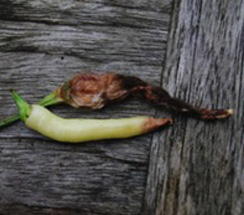Symptom:
- Brownish spots develop near the soil line or cotyledons
- Water-soaked lesions on leaves & stems darken and collapse
- Water-soaked spots that rapidly expand into large yellowish-green or grayish-brown, irregular lesions that are soft and spongy in texture
- Velvet-like fungus mycelium and spores are produced on the lesion surface under cool, humid conditions
Identification of pathogen:
- Botrytis cinerea - abundant hyaline conidia (asexual spores) borne on grey, branching tree-like conidiophores
- It overwinters as sclerotia or intact mycelia, both of which germinate in spring to produce conidiophores
- The conidia are dispersed by wind and rain-water and cause new infections
Favourable conditions and spread:
- Fungus sporulation and infection, is favored by cool and wet weather
- Temperatures of 17–23°C, RH - 90%
- Excessive application of nitrogen makes plants such as young transplants more susceptible to gray mold
- High canopy density creates conditions for extended leaf wetness at night and subsequent increased gray mold severity
|
 |
|
| Grey mould |
|
|

